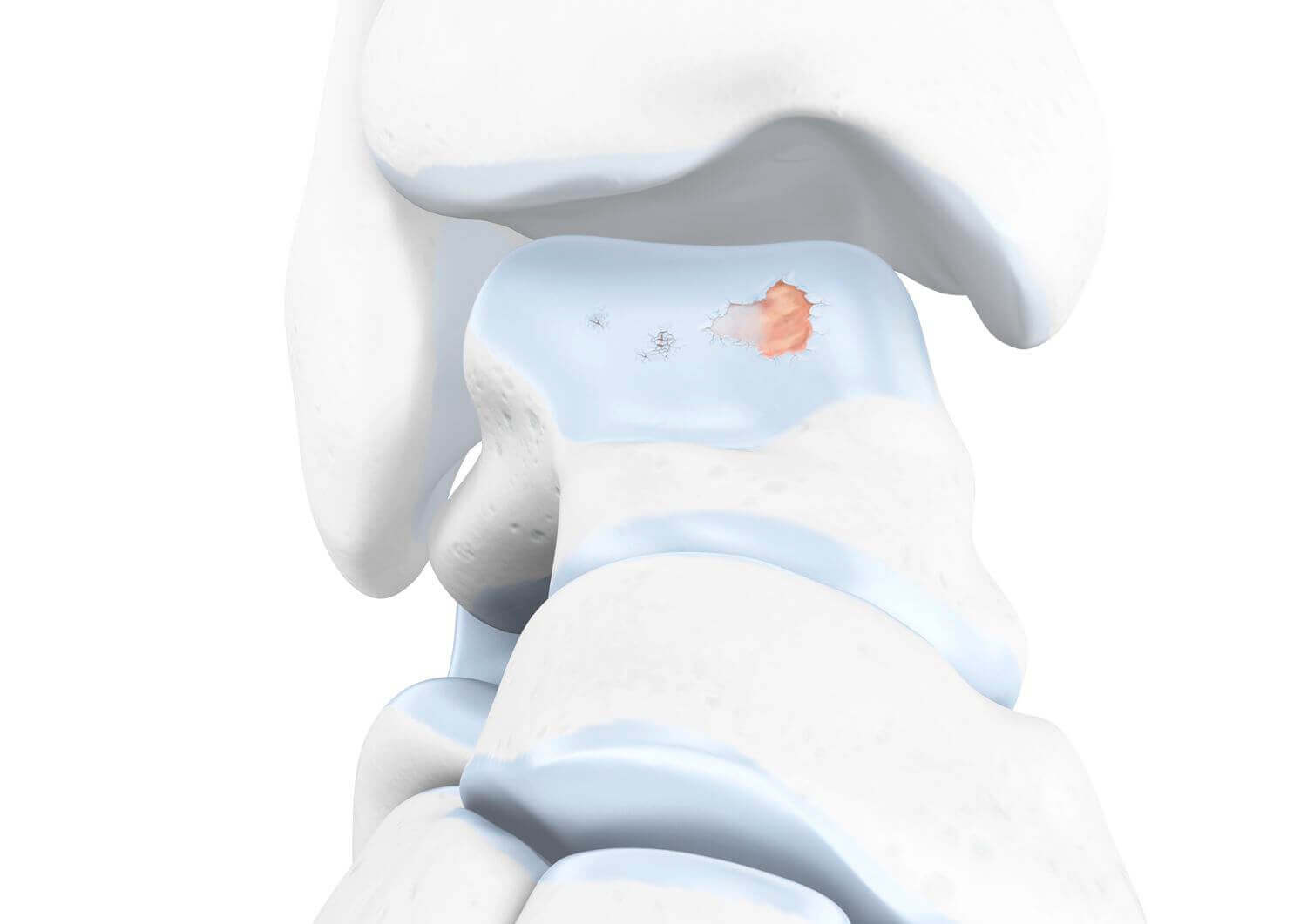If the ankle hurts during movement, this may be a sign of osteoarthritis of the ankle. This type of osteoarthritis is not generally a sign of aging. In many cases, a (sports) injury that hasn’t healed fully and/or many years of inappropriate mechanical stress trigger the development of this condition. If the load-bearing capacity decreases more and more, surgery is the last resort. However, the progression of the condition can be positively influenced, and there are various treatment options that can help prevent surgery.
What is osteoarthritis of the ankle?

Osteoarthritis of the ankle describes symptoms of wear in the joint cartilage in the upper and/or lower ankle. This wear is degenerative, meaning it cannot be reversed, or is caused by an accident. It results in the reduction of joint cartilage and narrowing of the joint space. As a consequence, the shock-absorbing function of the cartilage is lost and the joint surfaces rub on each other, thus causing pain. On the edge of the joint, new bone protrusions (osteophytes) develop, which will lead to restrictions in movement during the further progression of the condition.
The upper ankle is formed by the tibia and fibula in the area of the lower leg, and by the talus in the area of the foot. In the joint, the talus has a rounded surface that becomes narrower toward the back. If the talus is shifted forward or tilted in the joint, this will impair the fit of the joint elements. The result is wear and osteoarthritis of the upper ankle.
Osteoarthritis of the ankle following inflammation or metabolic disorders, such as gout or rheumatism, is rare but also possible.
Why is the ankle so prone to injuries and disorders?
The foot and ankle consist of a total of 30 small bones that form 38 joints. This area is one of the most complex bone structures in the human body for orthopedists.
The ankle transfers the entire body weight to the foot. During walking, running, and jumping, it sometimes bears more than five times a person’s weight. It is therefore the body’s joint which is subjected to most strain.
The joint connections of the talus have a crucial function in the mobility of the ankle, and ensure adjustment to uneven surfaces, for example. Lateral tilting motions and rotations are mainly implemented by the lower ankle. It is of major importance for the stability of the upper ankle. But osteoarthritis of the lower ankle is much more rare than osteoarthritis of the upper ankle.
Types and causes of osteoarthritis of the ankle
Depending on the cause, a distinction is made between primary and secondary osteoarthritis of the ankle. There isn’t usually an obvious trigger for primary osteoarthritis, merely age-related, natural wear. It is quite rare in the ankle area.
In most cases, those affected suffer from secondary osteoarthritis, almost always from consequential damage following an injury, such as supination trauma. This type of injury is rarely diagnosed by orthopedists or not treated until it’s fully healed. Twisting or spraining the ankle not only damages the ligaments but also the cartilage. Also in younger patients, ligament strains or a tear of the lateral collateral ligament can result in ankle problems which may cause osteoarthritis of the ankle.
Typical causes of osteoarthritis of the ankle
• Ligament instability after ligament strain or tear
• Fractured bones in the upper and/or lower ankle
Osteoarthritis of the ankle: what are typical symptoms?
The stage of osteoarthritis of the ankle determines whether osteoarthritis triggers pain and how much. Initially, the joint wear causes hardly any symptoms. The first noticeable signs are often pain deep in the joint or a pulling sensation. Pain when getting going in the morning as well as when subjected to strain also occurs. Those affected are no longer able to use the proper heel-to-toe movement. When osteoarthritis has progressed, the ankle loses its natural shape. Chronic pain occurs during later stages and the joint becomes stiff – with the typical drop-foot position.
Frequently occurring symptoms include:
- Start-up pain, pain when subjected to strain
- Piercing or pulling pain
- Postures to help relieve pain
- Pain radiating into the foot and lower leg
- Piercing pain when walking on uneven ground and during lateral tilting motions
- Misalignments of the ankle joint
- Stiffening of the ankle
Treating osteoarthritis of the ankle
To make a definitive diagnosis and adjust treatment, the physician can take X-rays. In cases of osteoarthritis of the ankle, bone spurs (osteophytes) on the edge of the joint and free joint bodies as well as cartilage fragments in the synovial fluid can be seen.
The goal of treating osteoarthritis of the ankle is pain alleviation and deceleration of joint wear. Treatment starts with conservative measures, such as physiotherapy, pain medication, or joint relief using special supports. Patients in advanced stages can be treated with cortisol injections and different kinds of surgery. This includes stiffening and ankle replacement surgery.
Supports help with osteoarthritis of the ankle
The MalleoTrain support has proven effective for stabilization and pain reduction in cases of osteoarthritis of the ankle. The textured knitted fabric activates circulation because its compression exerts an intermittent compression massage during walking. This improves the metabolism, reduces swelling, and helps with pain alleviation*. The tissue is provided with increased stimulation, resulting in more effective activation of the muscles – and thus helping to relieve the joint and cartilage. Two pads (viscoelastic function cushions) behind the malleoli activate the structures with every step and additionally massage the ankle. During the first stage of osteoarthritis of the ankle in particular, medical aids like the MalleoTrain can reduce pain and increase general mobility.


